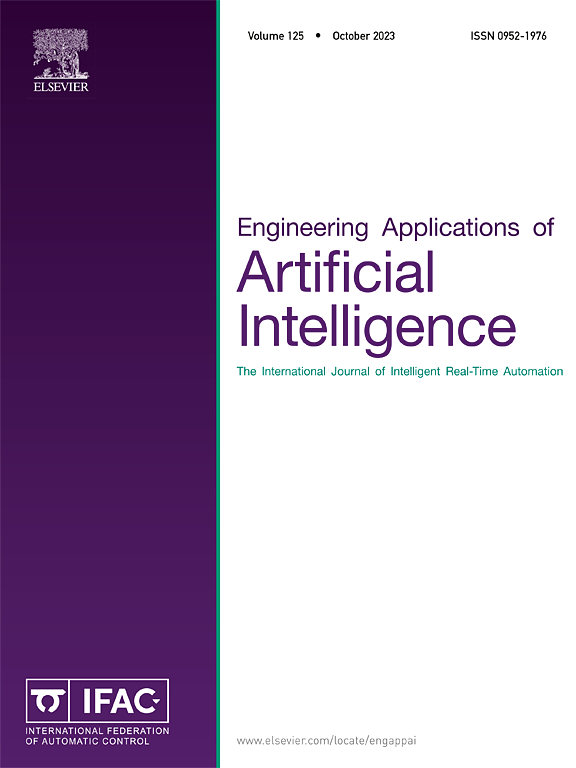Dual prototypes contrastive learning based semi-supervised segmentation method for intelligent medical applications
IF 7.5
2区 计算机科学
Q1 AUTOMATION & CONTROL SYSTEMS
Engineering Applications of Artificial Intelligence
Pub Date : 2025-05-01
DOI:10.1016/j.engappai.2025.110905
引用次数: 0
Abstract
In medical intelligence applications, the labeling of medical data is crucial and expensive, so it becomes urgent to explore labeling-efficient ways to train applications. Semi-supervised techniques for medical image segmentation have demonstrated potential, effectively training models using scarce labeled data alongside a wealth of unlabeled data. Therefore, semi-supervised medical image segmentation is a key issue in engineering applications of medical intelligence. Consistency constraints based on prototype alignment provide an intuitively sensible way to discover valuable insights from unlabeled data that can motivate segmentation performance. In this work, we propose a Dual prototypes Contrastive Network to motivate semi-supervised medical segmentation accuracy by imposing image-level global prototype and pixel-level local prototype constraints. First, we introduce a Background-Separation Global Prototype Contrastive Learning technique that utilizes the natural mutual exclusivity of foreground and background to separate the inter-class distances and encourage the segmentation network to obtain segmentation results that are more complete and do not contain background regions. Second, we design a Cross-Consistent Local Prototype Contrastive Learning techniques to extend the perturbation consistency of the two networks to the prototype’s localized response to the feature map, thereby shaping a more stable intra-class prototype space and producing accurate and robust pixel-level predictions. Finally, we comprehensively evaluate our method on mainstream semi-supervised medical image segmentation benchmarks and settings, and experimental results show that our proposed method outperforms current state-of-the-art methods. Specifically, our method achieves a Dice Coefficient score of 91.8 on the Automatic Cardiac Diagnosis Challenge dataset using only 10% labeled data training, 1.1% ahead of the second best method. Code is available at https://github.com/yuelily2024/DPC.
基于双原型对比学习的半监督分割方法在智能医疗中的应用
在医疗智能应用中,医疗数据的标注是至关重要且昂贵的,因此探索高效标注的方法来训练应用变得迫在眉睫。医学图像分割的半监督技术已经显示出潜力,可以有效地使用稀缺的标记数据和大量未标记数据训练模型。因此,半监督医学图像分割是医学智能工程应用中的一个关键问题。基于原型对齐的一致性约束提供了一种直观而明智的方式,可以从未标记的数据中发现有价值的见解,从而激发分割性能。在这项工作中,我们提出了一个双原型对比网络,通过施加图像级全局原型和像素级局部原型约束来提高半监督医学分割的准确性。首先,我们引入了一种背景分离全局原型对比学习技术,该技术利用前景和背景的自然互斥性来分离类间距离,并促使分割网络获得更完整且不包含背景区域的分割结果。其次,我们设计了一种交叉一致的局部原型对比学习技术,将两个网络的扰动一致性扩展到原型对特征映射的局部响应,从而形成一个更稳定的类内原型空间,并产生准确和鲁棒的像素级预测。最后,我们在主流的半监督医学图像分割基准和设置上对我们的方法进行了综合评估,实验结果表明我们的方法优于目前最先进的方法。具体来说,我们的方法在自动心脏诊断挑战数据集上仅使用10%的标记数据训练就获得了91.8的Dice Coefficient得分,比第二好的方法领先1.1%。代码可从https://github.com/yuelily2024/DPC获得。
本文章由计算机程序翻译,如有差异,请以英文原文为准。
求助全文
约1分钟内获得全文
求助全文
来源期刊

Engineering Applications of Artificial Intelligence
工程技术-工程:电子与电气
CiteScore
9.60
自引率
10.00%
发文量
505
审稿时长
68 days
期刊介绍:
Artificial Intelligence (AI) is pivotal in driving the fourth industrial revolution, witnessing remarkable advancements across various machine learning methodologies. AI techniques have become indispensable tools for practicing engineers, enabling them to tackle previously insurmountable challenges. Engineering Applications of Artificial Intelligence serves as a global platform for the swift dissemination of research elucidating the practical application of AI methods across all engineering disciplines. Submitted papers are expected to present novel aspects of AI utilized in real-world engineering applications, validated using publicly available datasets to ensure the replicability of research outcomes. Join us in exploring the transformative potential of AI in engineering.
 求助内容:
求助内容: 应助结果提醒方式:
应助结果提醒方式:


